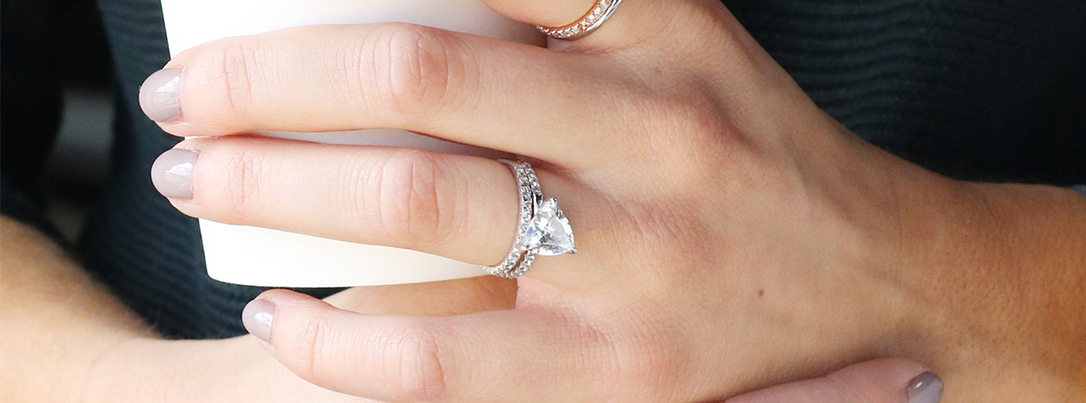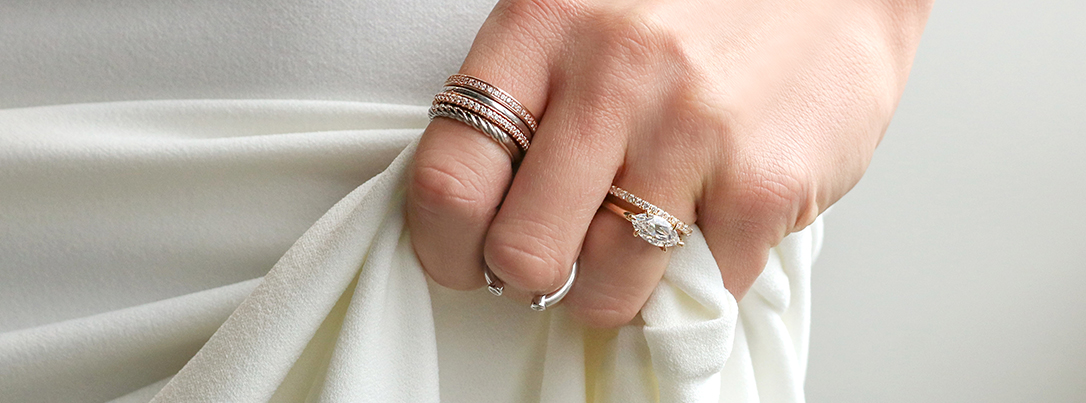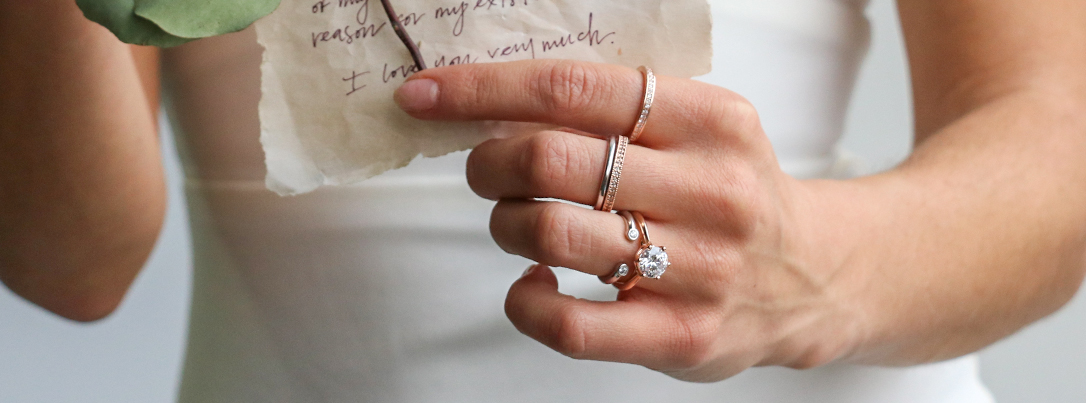How to Wear a Wedding Ring: Defining Your Personal Style
November 29th, 2019 / Alese Oldenburg
The jewelry you wear defines your personal sense of style, while a wedding ring set reveals so much more – it announces to the world that you’re not only in love, but that you’ve made a lifetime commitment to your special someone. While that significance is important, there’s no rule saying your rings shouldn’t make you feel chic and fashionable at the same time, whether you prefer traditional mined diamonds or modern simulated lab created diamonds. The problem is that your engagement ring and wedding ring are both worn, at different points, on the ring finger – the finger to the left of your middle finger – of the left hand. When should you take your engagement ring off, and do you even have to?
The short answer is that learning how to wear a wedding ring set depends entirely on your personal preferences.

Two Different Rings, Two Different Meanings
There are a few distinctions between an engagement ring versus a wedding ring. While the presence of one typically leads to the other, engagement rings and wedding rings are two separate pieces of jewelry to commemorate two distinct events in a lifetime. Each one should be carefully considered, not only for looks but also for “wearability,” as they will spend a great deal of time on your fingers.
How to Wear Engagement Rings
An engagement ring is typically set with a gem, such as a Nexus Diamond™ alternative, and is presented to the spouse-to-be as a symbol of promise when they ask for the wearer’s hand in marriage. While a persistent myth holds that this ring symbolizes a male partner’s financial ability to support a female partner in the home, this tradition is antiquated. Today, the presentation of an engagement ring puts far more emphasis on commitment and love, rather than any notions of required financial display. This ring can be relatively simple, as a solitaire stone with a plain band, or ornate and set with multiple stones, as seen in a pavé or channel ring setting. While colorless gems are still some of the most popular choices for the center stone on these rings, colored options, such as deep sapphire blues and rich ruby reds, are also available for unique styles. An engagement ring is almost always worn consistently from the time of an accepted proposal of marriage up until the wedding itself.
How to Wear Wedding Rings
A wedding ring is typically worn closest to the heart on your left ring finger as it’s meant to represent the symbol of your commitment to one another. However, this trend has been changing and evolving with people’s personal preferences and styles. A wedding ring is closer to a joint effort in terms of romantic accessorizing. Spouses’ wedding bands often resemble one another, but it’s no longer a “must” that these two rings match exactly. Depending on who buys the wedding bands, the look and feel of the rings are based solely on personal preference and style. As modern designs have influenced this classic piece of bridal jewelry, partners mix and match precious metals, designs, width, and more to create customized rings to symbolize their connection. These rings are most often exchanged at the wedding ceremony itself, usually directly after vows are spoken before an officiant. Once a wedding ring is placed on the hand, it’s usually worn daily for the rest of the wearer’s life, though it may be upgraded at a milestone anniversary or temporarily removed for safety when performing manual labor.
What Does it Mean to Wear a Wedding Ring on Your Right Hand?
While traditionally a wedding ring is worn on your left hand ring finger, it hasn’t been uncommon in recent years for women to wear one of their rings on their right hand ring finger. This is all based on personal preference. For some LGBTQ couples, wearing a ring on their right hand symbolizes their marriage or that they are in a monogamous relationship.

What Is the Correct Way to Wear Your Wedding Rings: Above, Below, Or Off Entirely?
Even the most pragmatic bride-to-be may have a bit of superstition sneak into her wedding proceedings: it’s very common for a bride to wear something old, new, borrowed, and blue at her ceremony to bring luck to her new relationship. That’s why a seemingly simple choice, such as where, when, and how to wear her engagement ring and wedding ring together, can trigger the need for a bit of research. A common question is “which goes first, the engagement ring or the wedding ring?”
Happily, there is no common wedding ring myth or superstition that implies anything less than good fortune, no matter how these two rings are worn together – or not. Some women are eager to wear their engagement ring as often as possible, even after the wedding: it’s not hard to see why they’d be excited to keep showing off their stone. If you’re considering wearing your engagement ring and wedding ring together, you’ll have several options:
- Left Hand, Engagement Ring on Top: Some wearers prefer this order of rings, as it represents the timeline of their relationship. The engagement ring stays on top (furthest away from the body), as it was given first, and the wedding ring stays “closer to the heart.”
- Left Hand, Engagement Ring on Bottom: For entirely practical reasons, some brides prefer this arrangement as it uses the wedding band to “secure” the gem-set engagement ring closer to the body. This makes the sparkling centerpiece of the bridal ring duo less likely to slip off or collide with everyday objects from the front edge.
- Left Hand Wedding Ring, Right Hand Engagement Ring: Rather than the hassle of wearing two rings that may or may not sit flush with one another on a single finger, some brides simply switch hands. Before the wedding ceremony, a bride may switch her engagement ring to the ring finger of the right hand, leaving the left-hand ring finger free for her wedding band. By wearing a right hand ring and her wedding band on her left hand, she gets to enjoy her bridal jewelry every day without feeling like her rings are sliding or rubbing against one another.
On the contrary, if you’d prefer to wear your wedding ring alone, you’re in good company. Some women prefer to keep their engagement ring safely tucked away in a jewelry box and wear it as a way to mark special occasions, such as anniversaries, birthdays, or holiday celebrations.

The Made-For-Each-Other Option
You and your spouse were meant to be, and with a little thoughtful planning, your engagement and wedding rings can be as well. One of the most common issues with wearing both rings on the same finger is that, due to the design of the setting on many engagement rings, the edges of the bands won’t sit flush with each other. That means slipping, sliding, and even uncomfortable pinching between the bands – hardly a recipe for inspiring romantic feelings. Bridal ring sets incorporate a common design in both the engagement and wedding ring, matching up edges or even interlocking the two in order to ensure a more comfortable wear.
- A notched style will feature a wedding band with a cutout or curve built into one edge. This is intended to nestle up against the protruding gemstone setting of the engagement ring. Note: because of the notch placement, this type of set may potentially only “work” in one orientation (engagement ring on top or on bottom), which should factor into your decision.
- A fused style can be created after the fact from rings that weren’t necessarily designed to work together. This option requires the intervention of a professional jeweler, and solders the engagement ring and wedding ring into a single wearable ring, preventing the rings from pinching or rubbing against each other. While it’s likely a more comfortable ring after the alteration, for obvious reasons, it’s a permanent fix. If you have concerns about the finished band feeling too wide on the underside of your finger, ask about incorporating a single bottom band with a wider top.
- A stacked style takes a more casual approach to the traditional bridal set, allowing the wearer to stack, arrange, and remove any of a series of small, unobtrusive bands that comprise her wedding and engagement rings as a whole. Typically worn in sets of 3 or 5, but potentially even more, these stacked bands use smaller set gems and modest profiles to nestle comfortably against each other. The upside of this approach is that adding or swapping out additional rings, such as a milestone anniversary ring, or a band celebrating the birth of a child, is effortless.
- A cradle style can take two forms: a third “ring” that acts as a frame (and, potentially, a comfortable separator) that surrounds the engagement and bridal bands, or the framing ring itself may be treated as an engagement or wedding band. These pieces interlock more closely than a notch style, and may need to be slipped off to disentangle them from the design if a wearer wishes to separate the bands. While this type of interlocking ring is beautiful, it does take more planning and consideration before the ceremony, and potentially even before the proposal. It may also incorporate set stones, which can incur an additional cost.

Things To Remember About Bridal Jewelry
For all the rich precious metals and sparkling stones that define them, the most important part of any engagement ring or bridal band is the person wearing it. As your love story evolves and changes, you may find that your taste in jewelry does as well – and that’s okay! Many couples “freshen up” their bridal jewelry at milestone anniversaries, treating it like a recommitment to one another. From the excited bride about to walk down the aisle for the first time to the happily married couple looking to renew their vows, choosing bridal jewelry that reflects what you mean to one another is a joyful occasion.
Whether you wear your engagement ring and wedding ring together or separately, the most precious part of your favorite bridal jewelry will always be the moments of love you share across a lifetime. May they be as luminous and numerous as the sparkling facets in a Nexus Diamond alternative stone.
*Diamond Nexus strives to provide valuable information, while being clear and honest about our products. The Nexus Diamond™ alternative is a patented lab grown stone that, among all simulants, most closely imitates the look, weight and wear of a mined diamond, with two exceptions – it is absolutely perfect in every way, and it costs significantly less. Price points and environmental facts expressed in this blog were taken from popular online retailers and may vary. Learn more about the environmental impact of mining by visiting our blog.
1 Raz, Gideon. “How to Wear Wedding & Engagement Ring Set.” Genesis Diamonds, March 16, 2015, https://www.genesisdiamonds.net/blog/education/how-to-wear-wedding-ring. Accessed October 25, 2019.
2 Scott, Richard. “Interlocking Wedding Sets And Bridal Rings.” Jewelry Secrets, February 6, 2019, https://www.jewelry-secrets.com/Blog/interlocking-wedding-sets-and-bridal-rings/. Accessed October 25, 2019.
3 Anatomy of an Engagement Ring.” Malak Jewelers, (no publish date), https://malakjewelers.wordpress.com/2014/12/27/anatomy-of-an-engagement-ring/. Accessed October 25, 2019.

